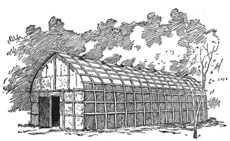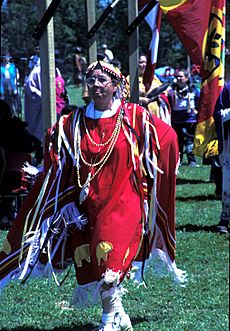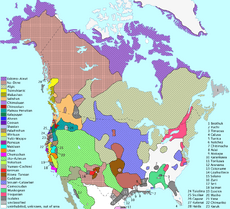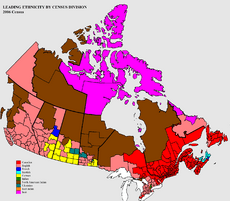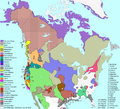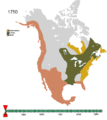First Nations facts for kids
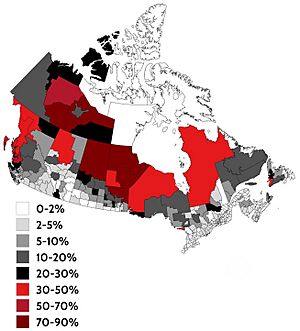
Population distribution of First Nations Canadians by census division, 2021 census
|
|
| Total population | |
|---|---|
| 1,048,400 (2021) 2.83% of the total Canadian population |
|
| Languages | |
| Religion | |
|
|
| Related ethnic groups | |
| Native Americans, Alaska Natives, Métis |
The First Nations (also called French: Premières Nations) are a group of Indigenous peoples in Canada. They are different from the Inuit and Métis peoples. Long ago, First Nations people lived mostly south of the Arctic Circle in Canada.
Today, there are 634 recognized First Nations groups or bands across Canada. About half of these groups live in Ontario and British Columbia. The term "First Nations" became official in the 1980s. It replaced the older term "Indian band," which some people found offensive.
History of First Nations Peoples
First Nations people settled and created trade routes across what is now Canada between 500 BCE and 1,000 CE. Many different communities grew, each with its own unique culture and way of life.
- In the northwest, you would find groups like the Slavey, Tłı̨chǫ, and Tlingit.
- Along the Pacific coast lived the Haida, Tsimshian, Salish, and Nuu-chah-nulth.
- On the plains were the Blackfoot, Kainai, and Sarcee.
- In the northern forests lived the Cree and Chipewyan.
- Around the Great Lakes, you would find the Anishinaabe, Algonquin, and Iroquois.
- Along the Atlantic coast were the Mi'kmaq, Maliseet, and Innu.
The Blackfoot Confederacy
The Blackfoot Confederacy lived in the Great Plains region, which includes parts of Montana in the U.S. and Alberta, British Columbia, and Saskatchewan in Canada. Their name, "Blackfoot," came from the dark dye or paint on the bottom of their leather moccasins. Some say this was because they walked through the ashes of prairie fires.
The Blackfoot people moved to the Great Plains from eastern Canada and the northeastern United States. They followed bison herds and gathered berries and roots. They only allowed trusted traders into their lands. They made treaties only when bison herds were nearly gone in the 1870s.
The Squamish People
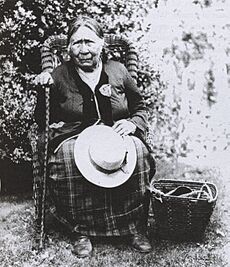
The history of the Squamish is passed down through oral tradition. This means stories, laws, and knowledge were shared by speaking and listening, not by writing. A writing system for the Squamish language was created in the 1970s, using the Latin alphabet. Elders, who are wise older people, have the important job of sharing historical knowledge with younger generations.
One story tells of a Great Flood. After the flood, people repopulated from villages near Gibsons. The first man, Tseḵánchten, built his longhouse there. Later, another man, Xelálten, sent by the Creator, appeared. These two men helped the Squamish population grow and spread across their territory.
The Iroquois Confederacy
The Iroquois people lived in what is now northern New York, southern Ontario, and the Montreal area of Quebec. The Iroquois Confederacy was formed around 1142, according to their oral traditions. They were skilled farmers, growing the "Three Sisters": maize (corn), beans, and squash. This helped them grow strong because they could feed many people. Over time, other groups like the Algonquians also started farming.
The Assiniboine People
The Assiniboine were close friends and trading partners with the Cree. They fought wars together against groups like the Gros Ventres and later the Blackfoot. The Assiniboine were a Plains people who traveled to follow bison herds in warmer months. They traded with European traders and worked with other tribes like the Mandan.
The Algonquin People
In their earliest oral history, the Algonquins came from the Atlantic coast. They settled along the Ottawa River, which was an important route for trade and travel. The Algonquin identity became clear about 2,000 years ago, near what is now Detroit.
The Ojibwe People
The Ojibwe are an Algonquian-speaking people. Their traditions, recorded in birch bark scrolls (called wiigwaasabak), say they came from the eastern parts of North America, also known as Turtle Island. They traded widely for thousands of years and knew many canoe and land routes.
Their oral history tells of seven great miigis (radiant beings) who appeared to teach them the mide way of life. Six of these beings stayed to teach and set up doodem (clans) for the people. These original clans included the Bullhead, Crane, Pintail Duck, Bear, and Little Moose.
The Nuu-chah-nulth People

The Nuu-chah-nulth are Indigenous peoples of the Pacific Northwest Coast. The name "Nuu-chah-nulth" describes fifteen different but related First Nations. Their traditional home is on the west coast of Vancouver Island. In the past, there were many more Nuu-chah-nulth nations. However, diseases like smallpox caused many groups to disappear or join neighboring groups. The Nuu-chah-nulth language is part of the Wakashan language family.
Kwäday Dän Ts'ìnchi
In 1999, the discovery of a naturally mummified body helped archaeologists learn a lot about Indigenous life before Europeans arrived. This body, named Kwäday Dän Ts'ìnchi (meaning "Long Ago Person Found" in Southern Tutchone), was found in British Columbia. Scientists used Radiocarbon dating to figure out the body was between 1450 AD and 1700 AD. Genetic testing showed he was a member of the Champagne and Aishihik First Nations.
First Nations Culture
National Aboriginal Day is a special day to celebrate the cultures and contributions of Aboriginal peoples in Canada. There are over 600 recognized First Nations groups, with more than a million people across Canada. Each group has its own unique culture, language, art, and music.
Traditional Foods
Many traditional Indigenous foods are now considered very Canadian. Foods like bannock (a type of bread), moose, deer, bison, pemmican (a dried meat mixture), and maple taffy are widely eaten. Métis stews, like barley stew, also have roots in Indigenous cooking. Other important traditional foods include fish, polar bears, musk ox, and caribou.
Music and Dance
First Nations peoples have many different musical traditions. Music is often used for social gatherings or private ceremonies. Social music might include dance music with rattles and drums. Ceremonial music often features vocal songs with percussion, used for important events like Midewiwin ceremonies and Sun Dances.
Traditionally, instruments were made from natural materials. Gourds and animal horns were used to make rattles. In woodland areas, people made horns from birch bark and drumsticks from carved antlers. Drums were usually made from carved wood and animal hides. These instruments provide the rhythm for songs and dances. Traditional First Nations people see song and dance as sacred. For many years after Europeans arrived, First Nations people were not allowed to practice their ceremonies.
Languages Spoken Today
Today, Indigenous people in Canada speak over thirty different languages. Most of these languages are only spoken in Canada. Sadly, many are slowly disappearing.
The languages with the most speakers are Anishinaabe and Cree, with about 150,000 speakers combined. Inuktitut has about 29,000 speakers, mainly in the Northwest Territories, Nunavut, and parts of Quebec and Labrador. Mi'kmaq has around 8,500 speakers, mostly in Eastern Canada. Many First Nations people now speak English or French as their main language.
Two of Canada's territories recognize Indigenous languages as official. In Nunavut, Inuktitut and Inuinnaqtun are official languages, along with English and French. In the Northwest Territories, eleven different languages are official, including Chipewyan, Cree, Gwich’in, Inuktitut, and Slavey.
First Nations Art
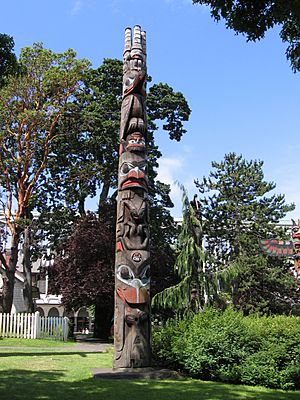
First Nations art is very diverse and beautiful. It includes carvings, paintings, weaving, beadwork, and more. Art often tells stories, shares history, and shows the beliefs of the people. Totem poles, like those made by the Haida, are famous examples of First Nations art. They are tall carvings that tell family histories or important stories.
Population and Communities
The First Nations population in Canada has grown a lot over the last century. Between 1900 and 1950, it grew by 29%. After the 1960s, the population grew even faster, by 161%, because more babies survived. Since the 1980s, the number of First Nations babies has more than doubled. Almost half of the First Nations population is under 25 years old. This means the population is expected to keep growing.
In 2021, there were 1,807,250 Aboriginal people in Canada, making up 5.0% of the total population.
Indian reserves are special lands set aside for First Nations by Canadian law and treaties. Some reserves are even located within cities, like the Opawikoscikan Reserve in Prince Albert. There are more reserves than there are First Nations groups because some groups were given multiple reserves.
First Nations people can be grouped into cultural areas based on how their ancestors lived before Europeans arrived. These areas often match the different physical regions of Canada. For example:
- People on the Pacific Northwest Coast focused on ocean and river fishing, especially for salmon.
- In the interior of British Columbia, people hunted, gathered, and fished in rivers.
- On the plains, bison hunting was the main activity.
- In the northern forests, animals like moose were more important.
- Near the Great Lakes and the St. Lawrence River, people practiced farming, growing corn, beans, and squash.
Today, First Nations people work in many different jobs and live in various places. However, their traditional cultures, shaped by nature, still strongly influence their lives, from their spiritual beliefs to their political views.
| Province/Territory | 1921 | 1931 | 1941 | 1951 | 1961 | 1971 | 1981 | 1996 | 2011 | 2016 | 2021 |
|---|---|---|---|---|---|---|---|---|---|---|---|
| Newfoundland and Labrador | - | - | - | 358 | 596 | 1225 | 3230 | 5430 | 19315 | 28375 | 28435 |
| Prince Edward Island | 235 | 233 | 258 | 257 | 236 | 315 | 440 | 825 | 1520 | 1875 | 2165 |
| Nova Scotia | 2048 | 2191 | 2063 | 2717 | 3267 | 4475 | 6305 | 11340 | 21895 | 25830 | 28050 |
| New Brunswick | 1331 | 1685 | 1939 | 2255 | 2921 | 3915 | 4610 | 9180 | 16120 | 17575 | 20955 |
| Quebec | 11566 | 12312 | 11863 | 14631 | 18876 | 32835 | 46855 | 47600 | 82420 | 92655 | 116555 |
| Ontario | 26654 | 30368 | 30336 | 37370 | 47862 | 62415 | 83860 | 118830 | 201105 | 236685 | 251030 |
| Manitoba | 13869 | 15417 | 15473 | 21024 | 29219 | 43035 | 59920 | 82990 | 114225 | 130510 | 134890 |
| Saskatchewan | 12914 | 15268 | 13384 | 22250 | 30628 | 40475 | 54720 | 75205 | 103205 | 114570 | 121175 |
| Alberta | 14557 | 15258 | 12565 | 21163 | 28469 | 44545 | 60005 | 72645 | 116670 | 136590 | 145640 |
| British Columbia | 22377 | 24599 | 24875 | 28478 | 38789 | 52220 | 64695 | 113315 | 155020 | 172520 | 180085 |
| Yukon | 1390 | 1543 | 1508 | 1533 | 2167 | 2580 | 3415 | 5530 | 6590 | 6690 | 6935 |
| Northwest Territories | 3873 | 4046 | 4052 | 3838 | 5256 | 7180 | 7635 | 11400 | 13345 | 13180 | 12315 |
| Nunavut | - | - | - | - | - | - | - | - | 130 | 190 | 180 |
| Canada total | 110,814 | 122,920 | 118,316 | 155,874 | 208,286 | 295,215 | 395,690 | 554,290 | 851,560 | 977,230 | 1,048,400 |
Other pages
Images for kids
-
Linguistic areas of North American Indigenous peoples at the time of European contact.
-
Assiniboine hunting buffalo, c. 1851
-
Pitikwahanapiwiyin (Poundmaker)
-
Mi'kmaq Grand Chief Jacques-Pierre Peminuit Paul (3rd from left with beard) meets Governor General of Canada, Marquess of Lorne, Red Chamber, Province House, Halifax, Nova Scotia, 1879
-
Buying provisions, Hudson's Bay territory, 1870s
-
Ethnomusicologist Frances Densmore recording Blackfoot chief Mountain Chief (1916)
-
Honourable David Laird explaining terms of Treaty #8, Fort Vermilion, 1899


